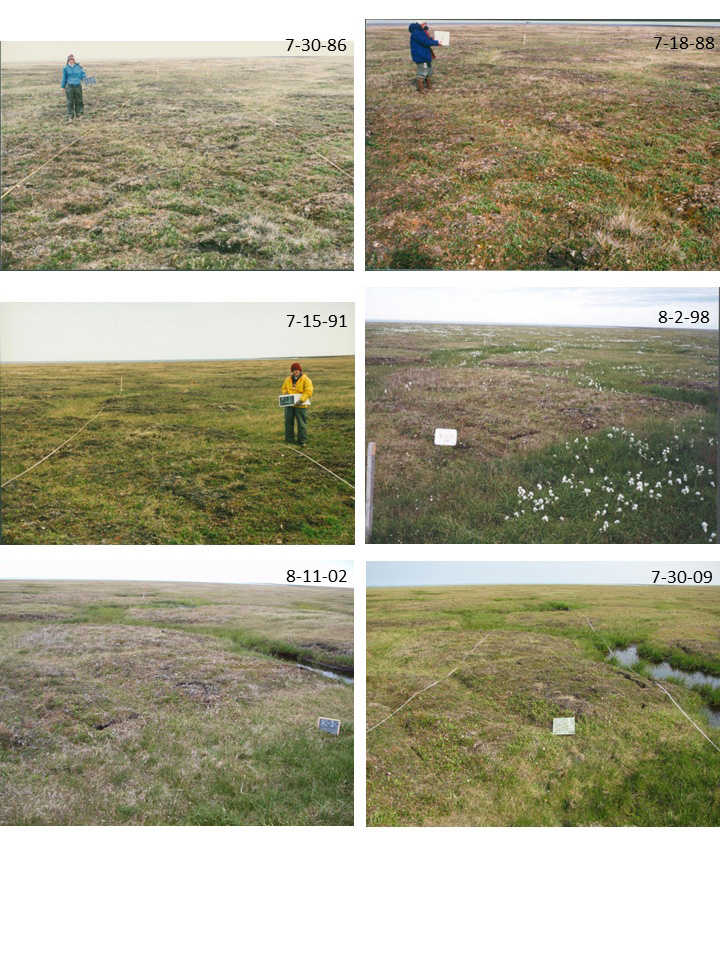When botanist Janet Jorgenson first visited a patch of tundra east of Kaktovik in 1988, it was flat, dry and thick with 29 species of lichens and mosses. Now, Tapkaurak is wet, gullied and fragrant with sedges and grasses. And, like other parts of Alaska’s North Slope, it is a few feet farther from the clouds.
Tapkaurak is part of what might be an arctic-wide thawing, draining and settling of the landscape. More than a dozen scientists co-authored a paper on places undergoing similar changes all over the top of the world. They wrote about 11 sites in Alaska, Russia and Canada.
All of the areas were like Tapkaurak, a control site to be compared to a nearby strip of tundra driven on by oil-exploration vehicles. None of them were bulldozed, buried under gravel or otherwise manipulated by people.
“These are not disturbed areas,” said Anna Liljedahl of the University of Alaska Fairbanks, first author of the paper in Nature Geoscience. “The only thing that can explain it is changes in climate.”
In the early 1990s, Jorgenson, who works for the Arctic National Wildlife Refuge, began noticing oddities in her 30-foot by 12-foot test strip within sight of the Arctic Ocean.
“My coworker Mike Emers said there was something weird going on with this plot,” she said.
Emers told her he couldn’t rate the amount of vehicle disturbance because the control strip was sinking almost as much as the driven-on tundra.
“After that we started paying more attention,” Jorgenson said.
What’s happening at Tapkaurak is the same thing occurring at other places north of the Arctic Circle. Below the ground surface, ice wedges that formed thousands of years ago are melting. Even though northern winters are still cold, recent summer temperatures have been warm enough to melt the top portion of the ancient ice in just a few years. That’s creating deeper channels above the ice wedges that often fill with water. Those depressions sometimes connect up to form small streams, allowing water to drain away.
Because ice makes up a good portion of the underground foundation of northern Alaska, thawing has dropped the landscape as much as three feet in some places.
“The whole surface in the Arctic Coastal Plain is sinking,” Liljedahl said. “It’s like sea-level rise the other way around.”
Jorgenson is less certain of universal slumping of the landscape. A majority of plots she’s working on have not reacted like Tapkaurak.
“Of 27 control plots, this is the only one with this dramatic subsidence,” she said.
It is natural for the tops of ice wedges to melt and refreeze, Jorgenson said. Over several decades, they can grow again after plants pop up in the troughs, cast shade and insulate the ground from summer heat. But that process requires dependable cold, winter and summer.
“We don’t have a steady state anymore,” she said. “We get more and more of the deep troughs, and it’s harder to recover.”
As Liljedahl was writing the paper, colleagues from all over the world mentioned undeveloped spots that were reacting to warmth the same way.
“If we had the paper in the works for much longer, we would have had an even larger dataset,” she said.
• Since the late 1970s, the University of Alaska Fairbanks’ Geophysical Institute has provided this column free in cooperation with the UAF research community. Ned Rozell is a science writer for the Geophysical Institute.

